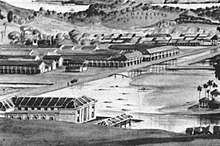Pearl's Hill
Pearl's Hill, briefly Mount Stamford, is a small hill in Singapore. Located in the vicinity of Chinatown, it is one of the few surviving hills in the city area. Pearl's Hill is well known for once being the site of the former multiple notable institutional buildings such as the Tan Tock Seng Hospital, Seaman's hospital and the Pearl's Hill Prison. The Pearl's Hill Prison is located there because of the close proximity to Sepoy Lines as it was thought to provide protection and security for the prison.
| Pearl's Hill | |
|---|---|
.svg.png) Pearl's Hill Location in Singapore | |
| Highest point | |
| Elevation | 147.638 feet (45.000 m) |
| Coordinates | 1°17′04″N 103°50′21″E |
| Geography | |
| Location | Singapore |
| Geology | |
| Mountain type | hill |
History

The hill was the location of gambier plantations owned by the Chinese who had occupied and settled there before Stamford Raffles' arrival in 1819. Captain James Pearl, the captain of ship Indiana which took Sir Stamford Raffles to Singapore in 1819, liked the look of the hill, and began acquiring plot after plot on the hill from the Chinese gambier planters until he owned the entire hill in May 1822. Pearl had the Chinese and Malay workmen built his house on top of the hill and cleared the slopes to plant pepper vines for him.
The hill was briefly named Mount Stamford by Pearl as a compliment to Raffles. When Raffles, having returned from Bencoolen, Sumatra in October 1822, heard how the hill had been acquired without his approval, he ordered its repossession by the British Government. Raffles would immediately relented and accorded the ownership of the hill back to Pearl. Captain Pearl, disgruntled by Raffles' actions, renamed the hill after himself.
In 1828, Captain Pearl retired back to England and his agents had the hill sold to the British Government for Rs 10,000. His name had remained associated with the hill since then.[1] Pearl's Hill used to be higher than Fort Canning Hill, thus the British colonial engineers decided to have the coolies shave off the top of Pearl's Hill, therefore lowering its peak to ensure their enemies would not be able to use the hill as an attacking position against the newly built Fort Canning.[2]
Pearl's Hill Service Reservoir
The Pearl's Hill Service reservoir was first mooted in 1897 to provide additional storage capacity and increase water pressure.[3] The project is described in some detail in a 1902 newspaper report which highlighted the rapid growth in water demand from 4.1 million gallons per day (average) in May 1900 to 5.4 mgpd in 1902.[4] Built of granite and concrete at a cost of $300,000, it was 70 feet higher than the Wilkie Road reservoir which it replaced. The work was undertaken by Municipal Water Engineer Robert Peirce (engineer) and his assistant L M Bell.
Upon completion there were concerns reported in the newspaper about the construction quality, stability and leakages from the reservoir. The structure of the reservoir on top of the hill rather than sunken into the hill (like Fort Canning reservoir) appears to have been the root cause of the public concern.[5]
When filtered water was first imported from Gunong Pulau in Johor, beginning in 1929, it was stored in Pearl's Hill Reservoir.
Pearl's Hill City Park
A city park of 9 hectares had since built around a reservoir on top of Pearl's Hill Terrace.
References
- Savage, Victor R.; Yeoh, Brenda (2013-06-15). Singapore Street Names: A Study of Toponymics. Marshall Cavendish International Asia Pte Ltd. pp. 290–291. ISBN 9789814484749.
- Chris, T. (1997, December 04). Pearl's Hill. Retrieved February 20, 2017, from http://eresources.nlb.gov.sg/infopedia/articles/SIP_116_2004-12-14.html
- http://eresources.nlb.gov.sg/newspapers/Digitised/Article/singfreepresswk18970914-1.2.93
- http://eresources.nlb.gov.sg/newspapers/Digitised/Article/straitstimes19020719-1.2.13
- http://eresources.nlb.gov.sg/newspapers/Digitised/Article/singfreepresswk19050125-1.2.62
